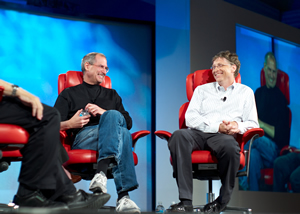 [div class=attrib]From Slate:[end-div]
[div class=attrib]From Slate:[end-div]
Steve Jobs resigned from his position as Apple’s CEO, or chief executive officer, Wednesday. Taking his place is Tim Cook, previously the company’s COO, or chief operating officer. They also have a CFO, and, at one point or another, the company has had a CIO and CTO, too. When did we start calling corporate bosses C-this-O and C-that-O?
The 1970s. The phrase chief executive officer has been used, if at times rarely, in connection to corporate structures since at least the 19th century. (See, for instance, this 1888 book on banking law in Canada.) About 40 years ago, the phrase began gaining ground on president as the preferred title for the top director in charge of a company’s daily operations. Around the same time, the use of CEO in printed material surged and, if the Google Books database is to be believed, surpassed the long-form chief executive officer in the early 1980s. CFO has gained popularity, too, but at a much slower rate.
The online version of the Oxford English Dictionary published its first entries for CEO and CFO in January of this year. The entries’ first citations are a 1972 article in the Harvard Business Review and a 1971 Boston Globe article, respectively. (Niche publications were using the initials at least a half-decade earlier.) The New York Times seems to have printed its first CEO in a table graphic for a 1972 article, “Executives’ Pay Still Rising,” when space for the full phrase might have been lacking.
[div class=attrib]More from theSource here.[end-div]
[div class=attrib]Image of Steve Jobs and Bill Gates courtesy of Wikipedia / Creative Commons.[end-div]
